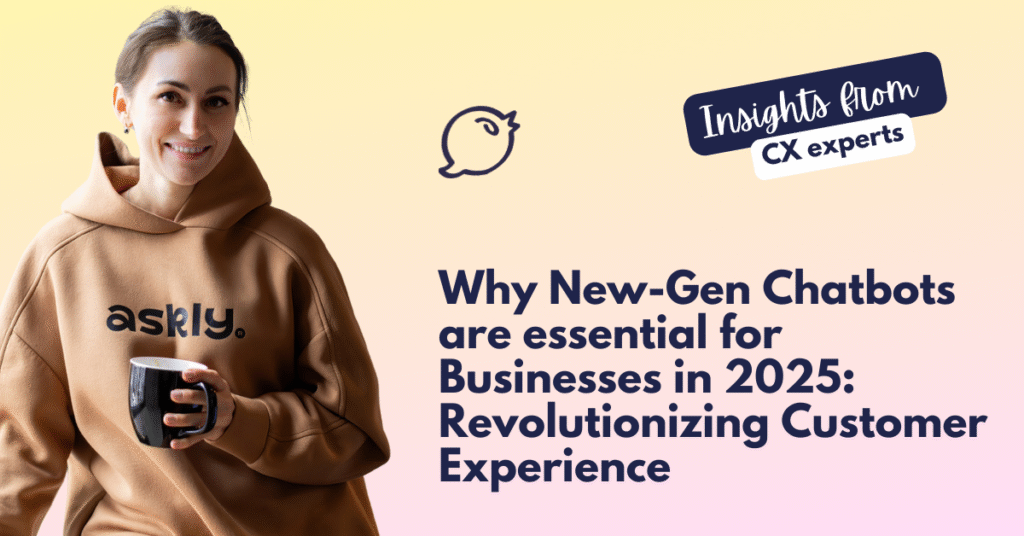Why New-Gen Chatbots are essential for Businesses in 2025: Revolutionizing Customer Experience

Sandra Roosna
Askly CEO & Founder

Nowadays customers are not ready to wait hours or days for the reply. The new generation AI-powered bot are nothing like old school chatbots.
100% human-like, offering help within seconds. Every interaction with your business defines loyalty. In 2025, those little moments are no longer just “nice to have”. They’re what make or break sales.
Chatbots have quietly moved from being futuristic experiments to everyday business essentials. They’re not just for big tech companies anymore. Small online businesses, local shops, travel agencies, and even beauty brands are using them to scale faster, save costs, and deliver better experiences.
Let’s dive into why this is happening and what it means for you.
Generative AI Is Changing the Game
Not long ago, chatbots could only handle FAQs like “What’s your refund policy?” or “What time do you open?” Now, with generative AI models we’re looking at a whole new level. These chatbots don’t just “reply”. They understand context, tone, and intent.
One e-commerce brand tested a generative AI chatbot last year. Within months, response times dropped by 40% and personalized product recommendations boosted sales by nearly a third. Imagine being able to serve hundreds of customers at once without overwhelming your team. That’s where we’re headed.
And here’s the best part: you don’t need a tech department of 50 people to do it. Tools are becoming easier, plug-and-play, and affordable enough for small businesses to benefit.
Beyond Support: Real Stories of Growth
Let’s get real: the chatbot revolution isn’t just about answering questions. It’s about growth.
- In e-commerce: A mid-sized retailer reported that after adding a chatbot, conversions jumped from 15% to 40%. Customers got instant answers about sizes, shipping, and availability — no abandoned carts, no frustration.
- In hospitality: Hotels are letting guests book rooms, order late-night snacks, or even check out via voice-enabled chatbots. For travelers, that’s convenient. For hotels, it’s efficient.
- In tourism: A travel agency saw a 20% spike in bookings just by letting customers build itineraries with a chatbot that “felt like” a personal trip advisor.
These aren’t isolated examples. Across industries, chatbots are saving time, reducing support costs, and unlocking entirely new revenue streams.
The Omnichannel Expectation
Customers today bounce between platforms — Instagram, email, websites, WhatsApp — and they expect businesses to keep up. Omnichannel chatbots are solving that headache.
Picture this: a customer starts chatting on Instagram about a skincare product, gets follow-up info via WhatsApp, and later completes the purchase on your website. The entire conversation feels seamless because the chatbot remembers everything.
According to Gartner, businesses that invest in omnichannel chatbots enjoy a 23% higher retention rate. That’s not a minor bump — that’s a competitive advantage.
Personalization and Prediction: The Secret Sauce
Here’s where chatbots get really exciting. They’re not just reactive anymore. They’re predictive.
Say a customer has bought running shoes twice in six months. The chatbot knows. The next time that customer browses, it suggests new arrivals, maybe even a special discount. That tiny nudge can double conversion rates.
In fact, surveys show that 41% of customers prefer chatbots that anticipate their needs. It feels less like “automation” and more like “attention.” And that’s exactly what builds loyalty.
ROI That Speaks Volumes
For any business leader, the question is always: does this pay off? The answer is increasingly yes.
- Beauty retailers have reported up to 35% ROI in the very first year of chatbot adoption.
- Small e-commerce shops see major cost savings — with some cutting support expenses by 40% while boosting sales at the same time.
- Travel companies, as mentioned, are converting more bookings just by reducing friction in the decision process.
It’s not just about technology; it’s about smart investment.
The Global Edge: Multilingual and Accessible
In 2025, your customers aren’t just local. They could be from anywhere. That’s why multilingual chatbots are such a game-changer.
One global brand used a multilingual chatbot and instantly saw a 15% growth in international customers. The reason is simple: when people feel understood, they engage more.
Accessibility matters too. Features like text-to-speech and adaptable content aren’t just nice add-ons — they’re essential. Businesses that prioritize inclusivity will not only reach more customers but also build a stronger reputation for care.
Don’t Ignore Security and Ethics
Of course, more AI means more responsibility. Customers trust you with their data, and breaches can break that trust instantly. That’s why businesses need to invest in encryption, data security, and compliance (think GDPR and beyond).
Equally important? Transparency. Customers deserve to know when they’re talking to AI. Hiding it can damage credibility. Instead, position your chatbot as a helpful assistant — not a replacement for humans.
What’s Next: Emotional Intelligence in AI
Looking forward, the next big leap is emotional intelligence. Imagine a chatbot that doesn’t just answer questions but senses frustration, excitement, or hesitation and adapts its tone accordingly. That’s the horizon for 2025 and beyond.
Businesses that prepare for these innovations now will be ahead of the curve. Not just keeping up, but leading.
Final Thoughts: Why This Matters for You
New generation quality chatbots are part of the core business toolkit, whether you’re a global brand, local store or a growing startup. They save time, scale customer service, personalize experiences, and drive sales.
And modern platforms like Askly AI are making human-like qualities simple.
With Askly, you can plug advanced chatbot capabilities right into your website or store, without needing to code or hire a big tech team. It’s your digital assistant that works 24/7, ensuring no customer leaves your site unanswered.
2025 isn’t just about adopting chatbots. It’s about adopting smarter, more human, and more empathetic chatbots. The sooner you start, the faster your business reaps the benefits.
About the author

Sandra Roosna
Askly CEO & Founder
Sandra Roosna is the founder and CEO of Askly, a multilingual customer support platform for e-commerce. With a background in international business and experience from Y Combinator’s Startup School, she built Askly to help online stores improve customer communication across Europe.
Want more happy customers with a small team? Askly can easily help you achieve it.
Free trial. No obligations. Start growing you business tomorrow.
Recent posts
AI in customer service that finally works.
No costs. No obligations.
